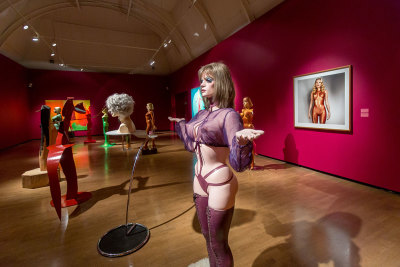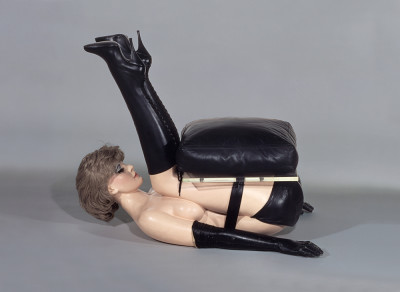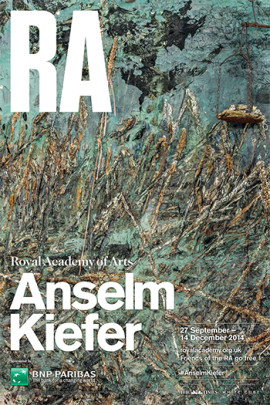Wednesday, December 10, 2014
Allen Jones, a British pop artist
This comprehensive retrospective, hidden away in Burlington Gardens, behind the RA, exposes a brilliant pop art career. While I did know Allen Jones's scandalous chair and table art, there is so much more to this talented man. He uses colour to convey energy and emotion. His drawings can be both accurate and dynamic. But it is his life size fibreglass models that are most impressive. Each woman is made as an individual and we can see works created across almost 50 years in one room, without obvious discord. He also cuts out large dynamic steel sculptures that capture individuals and couples dancing. The debate rages; is he a feminist or a misogynist? Not sure, but I think his longevity and adaptability reflects a true artist who is able to capture changing attitudes across time.
Roberta Smith critiques art critics
It is a special treat to sit in on another professional's important event, and enjoy the experience. It was the annual lecture of the International Association of Art Critics, held in the lecture theatre at Tate Britain. The speaker was Roberta Smith, a weekly columnist in the New York Times. Although her published title was Art Criticism: Personal and Political, she explained several other variants of what she intended to talk about. And it was very much like a chat with good friends; interspersed with some pithy and powerful insights. She also spent a long time inviting and responding to questions; often from very important local critics who wanted to grandstand their own views and opinions.
What I enjoyed most was her fresh and honest approach to art criticism; for her, the key was to interest people long enough that they wanted to go and see the exhibition she was commenting on!
She seemed critical about whether artists really know and own the meaning of their work. Many cannot explain or document the process of creation. So she aims to describe what she sees, and she focuses on describing what she calls content; the sublingual power of art to please, created by the artist's process of making and their sensibility. I tended to agree with her that art should not require a lot of interpretation, but I also recognise that we get to know some artists better than others.
I liked the way she avoids taking particular stances and writing to agendas, as she said they represent a narrow vision that is boring and predictable. I also agree with her goal to describe what she sees, and decipher the artist's content to explain why the particular piece is interesting. In my case, I can only explain art exhibitions in relation to my experience and knowledge of the artist or their content. For her, it seems her comments responate more broadly with contemporary American society and with her experience in understanding and contrasting many different forms of art.
Expressing modern history: Anselm Kiefer at the RA
This ia a monumental exhibition, by a living German, painting in France, in the most establishment of English art galleries! We are told at the beginning that Anselm was born near Freiburg in 1945, so he lived through the shadow of the crumbling Nazi regime in a corner of the country that was somehow sheltered by France and Switzerland. I found his work resonated with many aspects of contemporary Germany that I know: a deep connection with their land (in his case, the Black Forest and the Rhine River); a curiosity about the art, architecture and cultural legacy of the Nazis; and a respect for the jewish struggle and survival. While we did see his inner rebel in his first few paintings on display, where he portrayed the Nazi salute against a variety of backdrops, it was clear that he is more than a reactionary artist. His paintings are large and extremely textural and they convey big concepts. I liked the way he used sunflowers as a symbol for hope, even though at times they were suspended dead, upside down. He also used ash and splitting clay to represent the barren destruction. He cleverly portrayed the neo-classical architectural style created by Albert Speer during the Nazi regime, to recreate a sense of fear and foreboding; it was accentuated by having all four walls of a gallery hung with large paintings on this theme.
I also appreciated the way he was given freedom to create pieces for the individual galleries of the RA. His piles of gigantic leaden books and discarded canvasses contrast with the way we were drawn along the Rhine river in the last room. My only unanswered question; if this really was a contemporary interpretation of Germany history, where were the Germans in this exnibition?
Tuesday, December 9, 2014
The Courtauld Gallery - a hidden gem
The Courtauld Gallery is a small and surprising art museum in Somerset House, on The Strand in central London. It houses the impressive Courtauld collection, which traces the history of art from the early Renaissance. They have a very broad but comprehensive selection of Impressionist and Post-Impressionist paintings. Most notable painters have at least 1-2 pieces and there are more extensive collections from Monet, Van Gogh, Gauguin and Cézanne. It is a great reminder of artists I love. At this time of year, there is also a outdoor skating rink set up in the inner courtyard!
a panoramic view from The Shard
We were so lucky to visit this new London skyscraper on a sunny morning in December. Every other day in the preceeding week had been grey and damp. I could imagine the foggy vista of nothing. But I am reminded of the power of sunshine and blue skies. It transforms all those dark buildings into a thriving metropolis. The roads and trainlines resemble the arteries and veins, threading their way throughout the city.
I loved seeing the long white overground trains crawl like snakes up to and across the Blackfriars Bridge station. It was also great to pick out classic buildings, like St Pauls and Buckingham Palace. The River curves between east and west. There is still a lot of building in the capital; the expanded Tate Modern and many new glass skyscrapers are still growing in the city. Finally, I loved the shadows and reflections on the water. I also enjoyed walking up the last 2 flights of stairs to feel the power of the wind on the open air platform on the 71st floor. I loved seeing the tips of pointed glass just above us, and looking into the windows of a BA plane flying past!
It was not difficult to decide to extend our visit to investigate the restaurants on the 31st floor. Our luck continued and we were able to eat at a cancelled booking, in a corner table at Aqua Shard. The purple and brown decor served as a warm backdrop to the city views. Service was brilliant, as was the food and wine - a truly memorable experience.
Sunday, December 7, 2014
Egon Schiele recognises vulnerability
I am unsure why this exhibition of Egon Schiele's drawings at the Courtald Gallery is titled The Radical Nude, except that Victorian attitudes of nudity must still be present in English society. The power of these skilful drawings for me was in their sensitivity and honesty. The crisp and delicate lines reflected hidden muscles so faithfully and delicate pastel colours reflected unusual skin tones. In all, there was a deep respect for his models, including himself and his family. I did not succomb to the predominant propoganda message of ugly, gaunt, perverse street life. Instead I came away with a small cameo of an artist wanting to share his personal life at the turn of the century in Vienna. Yes, he was working with other great artists like Gustav Klimt and Oskar Kokoshka, who were also keen to break with tradition. But personally, I am sorry about his early death, three days after that of his wife, during the influenza epidemic of 1918. I wonder what he could have achieved had he lived a longer life?
Late Turner: impressed by explosions of colour and texture at Tate Britain
Perhaps it was good to be primed by the movie, which I thought was disappointing. I was hoping that Turner's real art might be different and this time I was truly impressed. Tate Britain had expertly curated 6 large rooms of his late works; painted between 1835-1851. It was a visually and emotionally stunning array of large mounted watercolours, complemented by many quick drawings on paper. It was difficult to imagine an established artist in his 60's and 70's creating these controversial masterpieces, although in retrospect it is clear that he broke with tradition, and was therefore misunderstood at the time.
Each room was visually stunning and closer inspection of many pieces revealed Turner's multiple talents. He was able to combine palettes of blue-brown-cream oceans or landscape combinations as creatively as orange-gold-pink sunsets.
Generally, he overshadows individuals and small villages with enormous skies; some convey idealistic and romantic sunsets while others are in the eye of a storm or in the midst of steam or fog; and there is often a hidden light shining through. In many pictures he skilfully draws in foreground and middle ground scenes, and many are partially obscured, as if looking through a window. I particularly liked his delicate scenes of European mountains, valleys and lakes, and rather dismissed his chintzy reproductions of the great mythical narratives.
It was also clear that, as a wealthy English artist and businessman, he had the means to travel to Europe and convey the grandeur of cities such as Venice, alongside Swiss mountains and lakes. He perpetuated the romance and enigma of the continent, with his tonal pallets of translucent watercolours. He also relished the opportunities to convey the colour and energy of real fires in the Tower of London and Houses of Parliament!
Subscribe to:
Comments (Atom)





